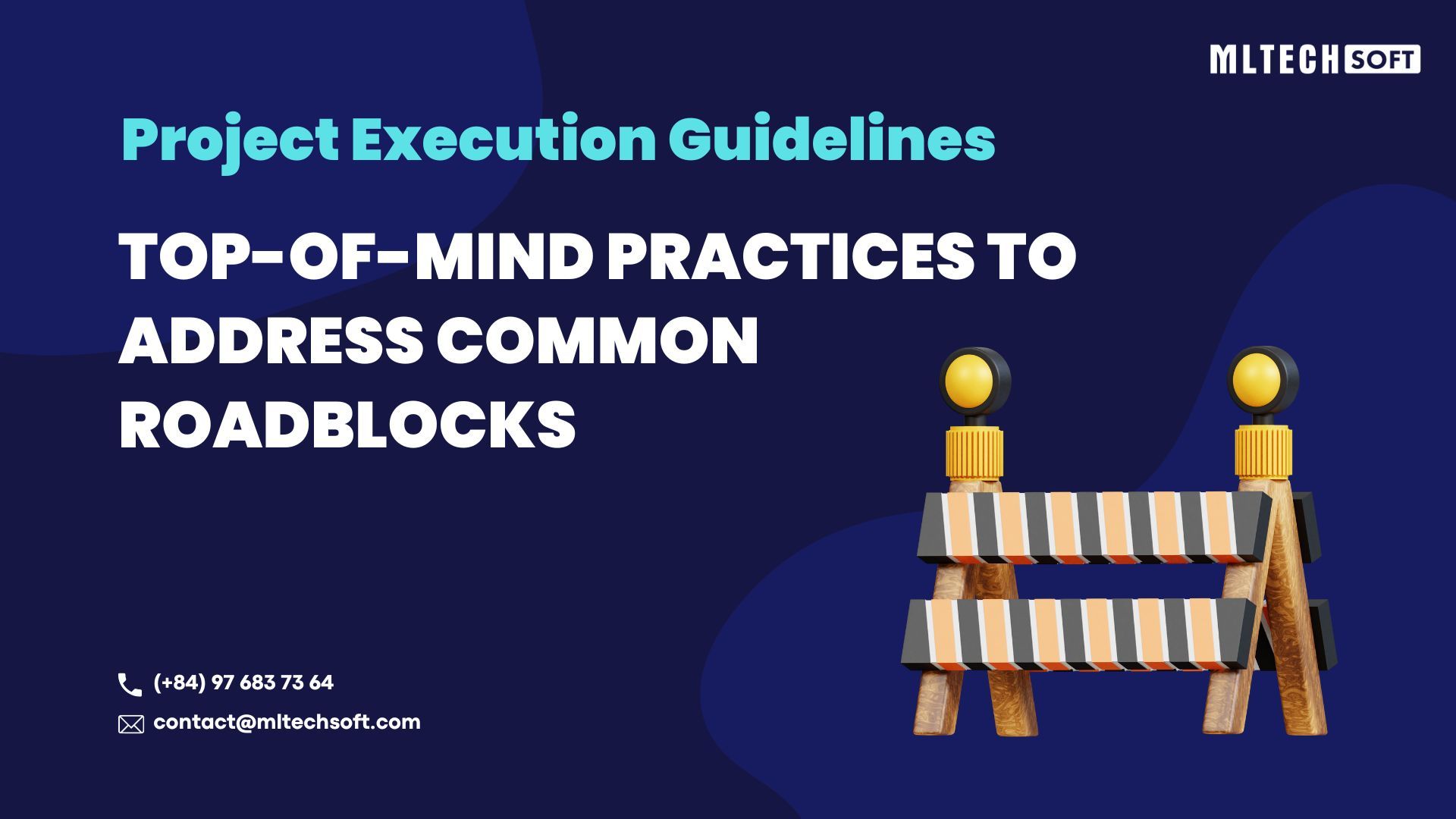Scroll down for more
Project Execution: Practices to Address Common Roadblocks

Project management is the disciplined process of strategically planning, organizing, and monitoring resources to achieve well-defined goals within a specified timeframe.
“Nothing worth having comes easy,” - Theodore Roosevelt
As the quotation says, there are examples of common roadblocks that can disrupt progress. By understanding the project management process and being aware of roadblocks, project managers and teams can take proactive steps to overcome challenges and achieve successful results.

1. Common Project Management Roadblocks
1.1. Inefficient Planning
In project management, inefficient planning refers to the absence of comprehensive, well-structured, and strategic preparation before project execution. It happens during the project planning phase.
Primary causes of inefficient planning:
- Unclearly defined project scope
- Lack of proper feasibility studies or understanding of project requirements
- Neglecting to assess potential risks during the planning phase
- Insufficient allocation of time for planning
- Inaccurate resource estimation or inadequate allocation
The equivalent consequences of the mentioned causes are:
- Goals become vague, making it difficult to develop a comprehensive plan
- Lack of essential information to determine the implementation steps and the necessary resources
- Unexpected obstacles during project execution
- There is not enough time to prepare for challenges that may arise during the project's execution
- Slowing down the progress and hindering effective planning
1.2. Insufficient communication and collaboration
Poor communication and collaboration refer to the lack of effective information exchange and cooperation among team members, project managers, customers, and other relevant parties.
Primary causes of insufficient communication and collaboration:
- Ineffective communication tools or channels
- Unclearness between project goals and individual responsibilities
- Different time zones and locations in global or remote teams
- Strict communication due to hierarchy
- Disagreements or conflicts between team members
- The absence of suitable collaboration tools
- Lack of trust among team members or between the team and management
The equivalent consequences of the mentioned causes are:
- Delays, misunderstandings, miscommunications, and missed project deadlines
- Conflicting actions can result in rework, wasted resources, and increasing project costs
- A challenge to real-time communication and delays in responses
- Delayed vital information and project bottlenecks
- Communication barriers and impeded collaboration
- Hampering the tracking of project progress
- Hiding information, poor collaboration, and increasing the risk of project failure

1.3. Resource misallocation and misuse
Misallocation and misuse of resources in project management refer to the inefficient or inappropriate use of project resources, including human, time, financial, and material resources.
Primary causes of resource misallocation and misuse:
- Inefficient project planning and estimation
- Indistinct project scope and inappropriately allocated resources
- Inadequate tracking and monitoring of resource usage
- Frequent changes in project requirements
- Ineffective resource management practices
The equivalent consequences of the mentioned causes are:
- Damaging the organization's reputation and rising risks
- Lower team productivity, more frustrated and demotivated team members
- Misuse without timely intervention, increased project costs, and budget overruns
- Disrupting resource allocation and delays in project timelines
- Over-allocation to certain tasks and under-allocation to others
2. Best Practices to Overcome Challenges in Projects
2.1. Implement business-fit management software
Business-fit management software provides features tailored to each organization's needs, such as project forums, resource workload, task tracking, centralized data, risk, time, and cost management, etc.
This option can significantly enhance project management capabilities, overcome challenges, and lead to more successful project outcomes.
2.2. Allow more time and apply models to optimize the planning stage
Allowing additional time during the planning phase allows for more diligent analysis, better risk identification, and clearer goal setting.
By incorporating optimization models, project managers can make data-driven decisions, optimize resource allocation, and predict potential risks. This approach increases project efficiency and minimizes obstacles.
2.3. Frequently monitor the project budget
Regular budget tracking allows project managers to keep abreast of financial progress, identify cost overruns, and make timely adjustments to avoid potential financial risks.
By intimately monitoring the budget, project managers can ensure that resource allocation is aligned with project requirements and meets budget constraints. This improves financial accountability and avoids monetary overruns on the project.

2.4. Assess team’s performance and carry out training sessions if required
Performance reviews enable project managers to identify team strengths and areas for improvement. Team members can enhance their capabilities, boost productivity, and better align with project goals through targeted training sessions.
This way, you develop a competent and motivated team, improving collaboration, communication, and overall project efficiency. Additionally, investing in the team’s development leads to higher-quality deliverables and project success rates.
2.5. Organize activities to keep employees engaged
Engaged employees are more motivated, productive, and committed to successful projects. By organizing team-building events, recognizing individual contributions, and creating a positive work environment, project managers can boost team morale, strengthen collaboration, and enrich communication.
Engaging activities also help reduce stress, prevent burnout, and encourage team camaraderie. This fosters a supportive project team that can tackle challenges with enthusiasm and creativity.
2.6. Conduct regular checkups to gather updates and feedback
Regular checkups help project managers stay informed about project updates and keep them on track. Gathering feedback from team members, stakeholders, and clients allows the leader to understand their concerns and resolve the problems in alignment with project goals.
This route advances effective communication, reduces errors caused by miscommunication to a minimum, and empowers project managers to proactively address issues, making the project process smoother.
Conclusion
In conclusion, clear communication, efficient resource allocation, strategic planning, team performance assessment, and proactive risk management are vital for overcoming common project management roadblocks. Business-fit management software also makes a large contribution to improving project outcomes. If you are unsure about your fit, identify your business needs with MLTech Soft now!
Get our blog
Want the latest and greatest from our blog straight to your inbox? Chunk us your details and get a sweet weekly email.
Read more in our blog

Project Management
The Impact of Dynamic Pricing on Customer BehaviorExplore the impact of dynamic pricing on customer behavior and learn how to implement effective pricing strategies.

Project Management
Focus in Scrum: Keeping Your Team on TrackDiscover effective strategies to maintain focus within your Scrum team, overcome common challenges, and boost productivity.

Project Management
Key Metrics for Mobile App SuccessDiscover the essential metrics for mobile app success, from user acquisition and engagement to monetization and performance.
MLTECH SOFT